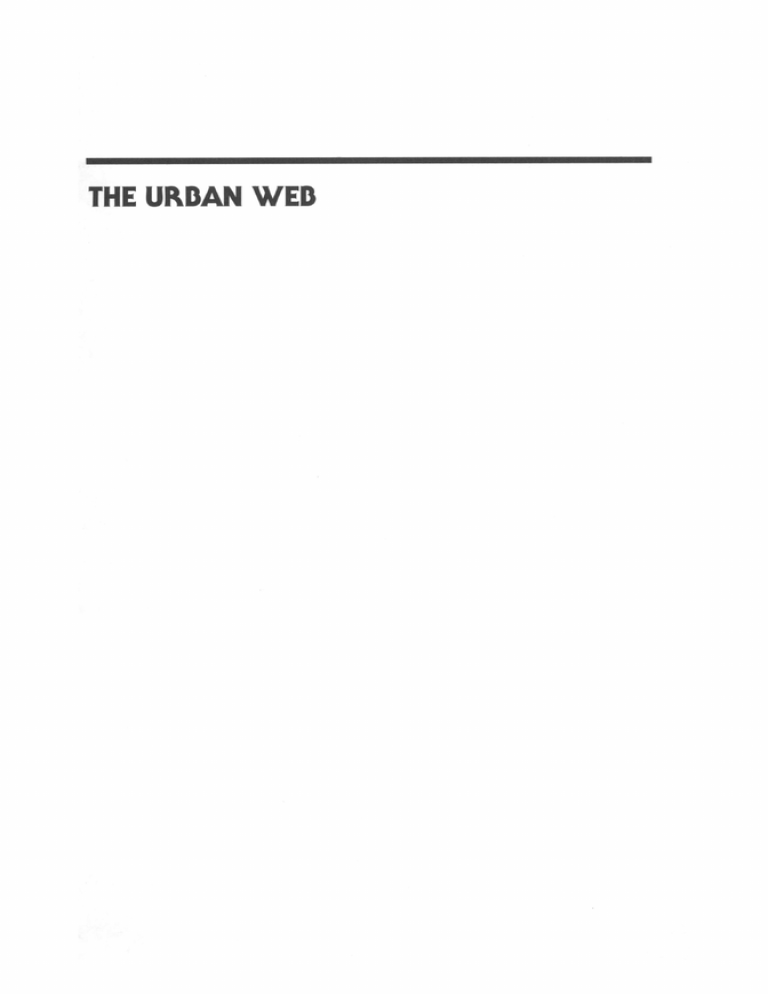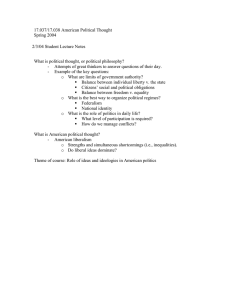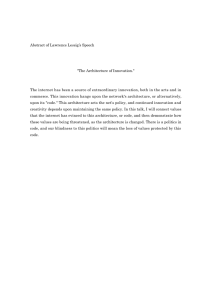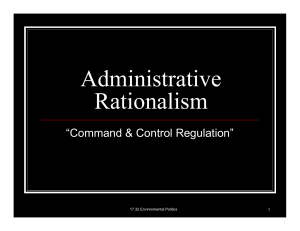
THE URBAN WED
NELSON-HALL SERIES IN POLITICAL SCIENCE
Consulting Editor: Samuel C. Patterson
The Ohio State University
THE URBAN WED
Politics, Policy, and Theory
Second Edition
Lowrence J.R. Herson
The Ohio State University
John M. Dollond
The University ofAlabama
Nelson-Holl Publishers/Chicogo
Project Editor: Dorothy Anderson
Text Designer: Tamra Campbell-Phelps
Illustrator: Corasue Nicholas
Text Compositor: Precision Typographers
Manufacturer: Capital City Press
Cover Painting: Christopher Buoscio,"Street to the City"
Library of Congress Cataloging-in-Publication Data
Herson, Lawrence J. R.
The urban web: politics, policy and theory / Lawrence J. R.
Herson, John M. Bolland. — 2nd ed.
p. cm. — (Nelson-Hall series in political science)
Includes bibliographical references and index.
ISBN 0-8304-1458-4 (pbk: alk. paper)
1. Cities and towns—United States.
2. Cities and towns—United
States—Growth. 3. Municipal government—United States. 4. Urban
policy—United States. 5. Sociology, Urban—United States.
I. Bolland,John M. II. Title. III. Series.
HT123.H47
1997
307.76'0973—DC21
97-27666
CIP
Copyright © 1998 by Nelson-Hall Inc.
All rights reserved. No part of this book may be reproduced in any form without per
mission in writing from the publisher, except by a reviewer who wishes to quote brief
passages in connection with a review written for broadcast or for inclusion in a maga
zine or newspaper. For information address Nelson-Hall Inc., Publishers, 111 North
Canal Street, Chicago, Illinois 60606.
Manufactured in the United States of America
109 8 7 65 43 2 1
The paper used in this book meets the
minimum requirements of American
National Standard for
Information
Sciences—Permanence of Paper for
Printed Library Materials, ANSI
Z39.48-1984.
To our wives and children
Libby D. Herson
&
Eric,Viktoria, and John
and
Kathleen A. Bolland
&
Anneliese
May they always know the pleasure of travel to far-off cities
Contents
Preface to the Second Edition
Preface to the First Edition
PART ONE
1
xvii
xxi
THE URBAN WED
The Urban Web: An Introduction
0
Inquiries Old and New 3
Urban and City Defined: The City in History and Logic
Politics and Public Policy
Public Policy
7
Politics
Choice, Change, and Constraints
2
An Almanac of Cities
13
Patterns and Variety 13
The Statistical City 14
The Sociological City 15
Good Cities and Bad
The Legal and Corporate City
Cities as Agents
17
vii
5
Contents
Cities and Courts
The Metropolitan Patchwork
The City as Proprietor
Cities, Towns, and Villages
The Village
20
The Town
The City
The Big Apple 21
Cities as Opportunity for the Chance Encounter
3
Theories of Urban Politics
25
Behold! An Inner Logic 25
Theory as Compressed Knowledge 25
Convergent Theories as Organizing Theories
Eleven Theories of Urban Politics
L
2.
3.
4.
5.
6.
7.
8.
9.
10.
11.
28
28
Grass Roots Democracy: A Prescriptive and Descriptive Tlieory
The Unwalled City: A Theory of Permeable Boundaries
A Theory of Social Learning: How Not to Solve City Problems
The Commodification of Land and Buildings: A Theory of Market
Externalities
Looking for Mr. and Ms. Big: A Theory of Influence
A Tlieory of Lifestyle andTerritory
A Theory of Urban Reform
A Theory of Urban Administration: Street-Level Bureaucrats
A Theory of Ideology and Interpretations
A Theory of Poverty and the Underclass
A Theory of Multiple Realities
Next Steps
PART TWO
4
23
38
A BACKWARD GLANCE
The Politics of Urban Development:
The Development of Urban Politics 41
Cities Moving West
41
The Colonial Town
43
Economic Patterns
Self-Rule
Property Rights as Civil Rights
Corporate and Political Patterns
Patterns of Social Control
The Early Republic (1789 to the Civil War)
Urban Growth
47
The City as a Symbol of Progress: The City and Land-Use Economics
viii
Contents
Social and Political Consequences of Industrialization
TheAge of the Common Man
The Industrial Age 52
The Political Machine
53
Businessmen and the Machine
The Business of Politics
Immigrants and the Machine
Urban Reform
59
Progressives and the City
The Reform Package
The Demise of the Machine
62
The Great Depression and Beyond
The Past Becomes the Present
PART THREE
5
64
65
THE RULERS AND THE RULED
Political Rules and Political Realities
in the City 69
An Extended Definition of Politics
69
Four Components of an Extended Definition of Politics
Public versus Private Action: The Zone of Demarcation
Rules of the Political Game
Majority Rule
Minority Rights
Peaceful Management of Conflict
73
Participation
Widespread Distribution of Benefits
Rules of the Political Game Applied to Urban Politics
Quality-of Life Issues
75
Community Conflict
Participation
Part- Time Politics
Government byAdministration
Private Poiver versus Public Power
Private Space versus Public Space
Financial Security
Urban Politics and Democratic Norms: A Theory
of Political Style 89
6
Forms of Municipal Government and Formal
Participants in the Urban Political Process
An Inventory of Municipal Governmental Structures
Weak-Mayor Plan
93
94
ix
Contents
Strong-Mayor Plan
Council-Manager Plan
Commission Plan
Town Meeting Plan
Norm versus Form: A Comparison of Adherence to
Democratic Norms
Majority Rule
Protection of Minority Rights
Participation
105
Peaceful Management of Conflict
Widespread Distribution of Benefits
Formal Participants and Their Political Roles
Tie Governing Body
The Mayor
The City Manager
The Municipal Bureaucracy
Other Formal Participants
7
110
Informal Citizen Participation in Local Politics
Who Participates and Why? 131
Individual Modes of Participation
Voting
131
135
Citizen-Initiated Contacts
Group Modes of Participation
141
Political Parties
Business and Economic Groups
Civic and Social Groups
Labor and Professional Organizations
Neighborhood Organizations and Homeowner Associations
Ad Hoc Groups
Participation Through Protest 161
Electoral Mobilization
Violent Protest
Nonviolent Protest
Political Participation in American Cities: An Assessment
Toward an Explanation of the Ungovernable City
8
Power in the City
177
The Early Studies of Community Power 177
A Theory of Stratification
A Theory of Pluralism
So, What's the Real Story? 179
Political Participation and Political Power in Two Cities
Determinants of Participation Reconsidered
Some Conclusions about Power in American Communities
171
Contents
Community Power: Toward an Alternative Theory 184
Interpersonal Power
Who's Powerful and Who's Not: An Inventory of Urban
Political Participants and Their Resources 187
Formal Political Participants
Informal Participants
Idiosyncratic Factors Affecting the Distribution of Power
Implications for Public Policy 196
PART FOUR
9
URBAN POLITICS AND POLICY:
CONTEXT AND CONSTRAINTS
The Styles and Stages of Urban Policy
201
Dreams and Reality: "World Enough and Time"
Constraints Imposed by Limited Knowledge
Unanticipated and Other Consequences
Urban Policies: A Problematic Context
Incremental versus Reconstructive Public Policy
201
203
Symbolic versus Substantive Policy
Limitations of Time
The Politics of Policy Making: Four Types of Policy
Regulatory Policy
Distributive Policy
Redistributive Policy
Development Policy
10 Policy Entrepreneurs and Agendas
208
215
Policy Entrepreneurs 215
Mayors and Managers
Land Developers and Business Leaders
Policy Entrepreneurs and Development Policy: A Tale of
Several Cities
217
Richard C Lee and New Haven
Henry Ford and Detroit's Renaissance
James Rouse and the City as Festival
Stages of the Policy Process 222
Agenda Setting
Policy Formulation
Agenda Setting and Policy Formulation as Interacting Processes
Policy Implementation
XI
Contents
PART FIVE AN EVEN LARGER WEB: CITIES, STATES,
AND THE NATION
11
Beyond the Central City: Cities, Their Suburbs, and
Their States
231
Politics and Policy in the Metropolitan Region
232
Cities and Their Suburbs
Industrial Parks and Edge Cities
Closed and Gated Communities
Counties
Special-Purpose Government
The Port Authority of NewYork and NewJersey, or Wliat's Wrong with
Special-Purpose Government
Appraising the Metropolitan Patchwork
Simplicity versus Organized Complexity
241
A Theory of Democratic Responsibility
Prescriptive Theories of SocialJustice and Social Equity
SocialJustice and Social Equity in the Metropolitan Area
The Metropolitan Area as a System
Tie Metropolitan Area as a Bargaining Arena
Steps toward Metropolitan Integration 247
Annexation
Service Delivery Contracts
City- County Consolidation
Two-Tier Government
Councils of Government
"To Thine Own Self Be True": Counterlogic and
Countertrends
253
Old Settlers versus New
Another Dimension of Equity: Race and Ethnicity in Central Cities
Cities and Their States
256
Legal Principles of City-State Relationships
256
Dillon's Rule
A Bold and Meddlesome Hand
Rural-Urban Conflict
Home Rule
258
260
Cities and States: Mandates, Politics, and Bargaining
Mandates
Tie City as Lobbyist: Legislative Policy Formation
The City as Lobbyist: Policy Implementation
An Even Larger Web 264
12
Cities and the National Government
Cities and the Nation
267
The New and Newer Federalism
xii
267
262
Contents
The New Deal and the New Urban Politics
National Policy and Interest Groups
Roosevelt and the New Deal
272
272
273
Jobs and Mortgages
Housing for the Poor
The Truman Presidency 278
The Johnson Presidency 280
The Civil Rights Acts of 1964 and 1965
The Great Society
The Nixon Presidency: A Change in Approach
287
Block Grants
Revenue Sharing
Presidential Policies after Nixon
291
The Presidencies of Gerald Ford andJimmy Carter
The Reagan and Bush Presidencies
The Clinton Presidency'.Advancing toward the Year 2000
The Supreme Court's Urban Policies 293
School Segregation
Housing Patterns and Residential Segregation
Affirmative Action
Next Steps 302
PART SIX
MUNICIPAL FINANCE AND SERVICE
DELIVERY
13 Municipal Finance: A Prelude to the Urban Service
Delivery Saga 305
Growth and Retrenchment
Taxes
306
307
Property Tax
Sales Tax
Income Tax
Other Taxes
User Fees
317
Rationale and Level of Use
Problems with User Fees
Intergovernmental Revenue
322
Federal Aid
State Aid
Other Sources of Municipal Revenue
Utility Charges
Minor Sources of Municipal Revenue
Bonded Indebtedness
325
326
xiii
Contents
14 Growth, Decline, and Resurgence of Urban Service
Delivery: 1945 to the Present 331
Service Delivery as the Raison d'Etrc of the
American City: 1945-1978 331
Garbage and Garbage Collection
Crime and Law Enforcement
Fires and Fire Protection
Leisure Time and Recreational Activities
Transportation and Streets
Education and Public Schools
Services for the Needy
The Theme Restated
The Decline of Urban Services: 1979-1982
348
New York on the Verge of Bankruptcy
Taxpayer Revolt
Economic Stagnation
Population Shifts
Federal Cutbacks
The Overall Effect
Creative Finance in the City
Cutting Back Services
Coproduction and Volunteerism
Improving Efficiency
359
User Fees
Privatization and Contracting-Out for Services
The Resurgence of Urban Service Delivery:
1983 to the Present
PART SEVEN
369
CHALLENGES FOR THE FUTURE
15 Poverty and the Urban Underclass
375
Postindustrial Marginalization 376
Poverty in Urban America 378
Demographics of Poverty
Living and Dying in Poverty
The Concentration of Poverty and Growth
of the Underclass
383
Explanations for the Growth of Ghetto Poverty
Definitions of the Underclass
Race and Class
Underclass Behaviors andTlxeir Impact on City Life
Underclass Populations 395
The Homeless
xiv
Contents
Public Housing Residents
The Underclass and the Future of Cities
408
Poverty, Urban Services, and Public Policy
409
16 Urban Services, Market Considerations, and the
Underclass
411
The Ramifications of National Urban Policy
Inequality in Education 413
School Desegregation Revisited
Other Sources of Inequality in the Schools
Tracking andAbility Grouping
412
Other Policies
The Politics and Policies of Residential Segregation
418
Real Estate Practices
Banking Practices
Siting Decisions
The Extent of Residential Segregation inAmerican Cities
Inequality in the Criminal Justice System 428
The Police
The Courts
The War on Drugs
Inequality in Health Care
432
Geographical Disparities in the Distribution of Services
within Cities
434
The Shaw Decision
Tests of the Underclass Hypothesis
The Underclass Hypothesis Reconsidered
Distribution of Services on the Basis of Need
Other Examples of Geographical Inequity
Intercity Disparities in the Delivery of Urban Services
Poverty and Urban Policies 442
438
17 Reinventing the City: Policy and Reform as the
Century Turns 445
New Economic Bases for the City
The Office Tower Boom
446
Convention Centers, Hotels, and Downtown Shopping Centers
Professional Sports
Downtown Development: A Critical Assessment
Inner-City Economic Development 452
Enterprise and Empowerment Zones
Enterprise and Empowerment Zones: A Critical Assessment
Community Development Programs
Community Development: A Critical Assessment
xv
Contents
Housing and Homelessness 458
Dealing with Homelessness
Low-Cost Housing for the Homeless
Responses to Homelessness: A Critical Assessment
Public Housing as Solution or Public Housing as Problem
Decentralization of Public Housing
Privatization of Public Housing
Revitalization of Public Housing
Restricted Tolerance
Public Housing Reforms: A Critical Assessment
Ending Welfare as We Know It 468
1996 Welfare Reform Legislation
Welfare Reform:A CriticalAssessment
Looking toward the Future
472
EPILOGUE: LOOKING TO THE FUTURE
18 The Shape of Things to Come
Themes and Counterthemes
The Function of Cities
477
477
A City of Friends and Strangers
Governing Urban America
The Contested City
The Culture of Cities
The City in History
The Physical Shape of Things to Come 480
Population Shifts and Demographic Trends 482
Urban Riots and the Two Societies
483
Urban Problems and Urban Policies
484
Things to Do, Programs to Be Tried
485
The Urban Poor
487
Cities and the Future: Through the Glass Brightly and
Darkly Seen 488
A Contravening Interpretation
Through the Glass Brightly: A Turn to the Future
References
493
Author Index
529
Subject Index
539
463
Preface to the
Second Edition
Much has happened to American cities since the Urban Web was first pub
lished. But even more has remained as it was. Thus, the idea of understanding
cities through the concept of a web continues to be valid. So too is the idea
that cities today are best understood by looking at their past. And what that past
history suggests is that American cities are constantly changing,endlessly recre
ating themselves.
As Alexis de Tocqueville, perhaps our most perceptive foreign visitor,
observed more than a century and a half ago,"An American ... changes his res
idence ceaselessly." Today, as in the past, the character of city populations
changes: New arrivals come to the city and old settlers leave for the safety and
amenities of the suburbs. Surrounding suburbs grow. The central city is beset
with problems that are in the city but not of its making.To adjust to a chang
ing population and to compensate for revenues lost through population
change, central cities must find new ways to perform essential services and, if
possible, to staunch urban decay.
Ten, twenty, and thirty years ago, the engines of urban change were the
economics of the private market joined to ambitious government programs.
There was, in those days, an optimism about the capacity of government to
improve the lives of its citizens and to alleviate social suffering. The results of
Prefoce to the Second Edition
that optimism were massive governmental enterprises—each with enormous
impact on our cities.
Today, much of that optimism has disappeared. In its place is a wave of
pessimism with respect to government's ability to accomplish major improve
ment in the quality of its citizens' lives. The era of big government is over, pro
claim both the Congress and the president. If a better tomorrow is to be
achieved, it will be through state and local programs, working in concert with
a smaller, less ambitious national government. Thus, the national government is
not soon likely to underwrite programs of massive aid to our cities. As a con
sequence (as it has been through much of our history) the economics of the
private market have once again become the primary engine of urban change.
Two of the most recent consequences of that market are now everywhere
on the urban scene: Common interest developments and edge cities. Common
interestdevelopments (condominiums, fenced and gated communities) are sup
ported and controlled by "private governments," dedicated to keeping out
those whom their governors tag as undesirables. Edge cities are urban enter
prises built by private developers on the suburban fringe and at the city's edge,
dedicated mostly to business and office spaces and shopping malls. What gives
both places their contemporary quality lies in a threefold fact: Mostly they are
newly settled and unincorporated urban places. As private enterprises, they per
form for a fee many of the services ordinarily undertaken by urban govern
ments. Reminiscent of the walled cities of the Middle Ages, they use private
power to monitor and control access to their domain.
As we said in the first edition, suburbs tend to have revenues sufficient
for their governments' needs. As home to a mostly middle-class population,
their residents have both social skills and personal funds sufficient to sustain
their suburban lives. In stark contrast, older central cities lack revenues sufficient
for their governments' needs.And they are awash in a sea of problems that turn
on matters of poverty and race. About those problems, little has changed in
recent years, except that they receive more attention in magazines and news
papers (and in the pages of academic journals) than they did a decade ago. Nor
has their web of connections changed: Poverty and race continue to connect
to urban crime and urban decay, and both, in turn, connect to the outward
flight of those sufficiently well-off to seek the comparative safety of suburban
homes and streets. And all such problems and trends continue to connect to the
awesome power of the automobile to determine where the urban dweller lives,
works, and shops.
But, continuity is not fixity. What seems mostly to have changed in recent
years is our society's diminished willingness to invest civic energy (and govern
ment programs) into saving and bettering our older cities, along with an
increased willingness to invest civic energy in new towns and new develop
ments on the urban edge. In doing so, and increasingly, we permit private
developers to control the style and pace of urban change.Thus, an old problem
xviii
Preface to the Second Edition
remains:What can we do to preserve and improve our older central cities?And
more important, what can we do to improve the lives of those who live there?
Our current thinking about cities continues to benefit from those peo
ple who encouraged and supported the collaboration that led to the first edi
tion of The Urban Web. In addition, the second edition has benefited from dis
cussion with Debra Moehle McCallum and Michael L. Berbaum, both of the
Institute for Social Science Research at the University of Alabama. This, as
well as the first edition, was edited by Dorothy J. Anderson and designed by
Tamra Campbell-Phelps; both editions benefited from their careful attention,
and we owe them a special debt. Finally, a second edition would not have
been possible without the help of people, far too numerous to mention by
name, who provided invaluable assistance in updating statistics about cities
and urban services.
xix
Preface to the
First Edition
Books, like rivers, have many sources; but unlike rivers, a book may have more
than one destination. Among the sources that feed our book are several excel
lent textbooks now in print on urban politics.We acknowledge our debt to the
conceptual frameworks provided by Charles Adrian and Charles Press (1977),
John Harrigan (1989), Bryan Jones (1983), Dennis Judd (1988), Robert
Lineberry and Ira Sharkansky (1978), and Clarence Stone, Robert Whelan, and
William Murin (1986).
Another source for this book is our own research on the politics of sev
eral small cities in Alabama, Kansas, Ohio, Colorado, Montana, and the state of
Washington. In addition to instilling in us a good deal of respect for the polit
ical process in small-town America, our research also afforded insight into the
manner in which policy and politics vary according to city size and geographic
region. Thus, in writing this book, we have attempted not to slight small cities
nor presume that only big cities have significant problems.
A third source for this book is our preoccupation over several years with
the American value system and American political theory. This preoccupation
has led us to attempt a stance of ideological neutrality in discussing matters of
market economics, zoning, race, poverty, service delivery, and central-city
decline. Our purpose is to enlighten and explain, not to convert the reader to
xxi
Prefoce to the First Edition
an ideological point of view. But we are also mindful of the difficulties of keep
ing this stance. As a professor of literature recently reminded us: No student of
human affairs can escape his or her own involvement with the subject being
studied.
Both of us are city-travellers. We visit great cities as often as we can, tak
ing pleasure in their architecture, their energy, their historic roles as creators and
transmitters of culture. In writing this book, we have attempted to convey some
sense of this pleasure, along with what Kevin Lynch (1960) calls"the image of
the city."
A book may have several destinations. We have set our compass by the
polestar of social science theory, hoping thereby to set our book apart from
most others by its attention to theory. Our goal throughout has been to make
explicit the theories that organize our knowledge about urban politics and that,
accordingly, do most to explain those politics.
We have also attempted to steer toward the reader whose educational
home is in the liberal arts. Our goal has been to work toward a triad of liberal
arts traditions: To see how the past flows into the present, to see that all social
processes are interconnected, and to understand that abstract ideas have realworld consequences.
In attempting to lay bare the real-world consequences of abstract ideas—
especially those that nest inside ideologies—we are mindful that most of our
readers will have had first-hand experiences with cities and city life. Our book
is thus an attempt to put those experiences in perspective, to offer a theoreti
cal framework within which our readers may better understand their own
urban experiences, and to provide them with intellectual tools that will sharpen
their judgment about present and future urban problems and policies.
But of all the goals that guide our book, none is more important than the
one we take from the distinguished historian of art, Kenneth Clark (1956). Like
him, we have done our best to "look with fresh eyes on a subject tarnished by
familiarity."
We owe much to several persons for their encouragement and for their
critical reading of our book in manuscript state.
Professor Emeritus Richard C. Snyder, the former Director of the
Mershon Center of The Ohio State University, was first to encourage and sup
port the collaboration that brought about the book. The present Director of the
Center, Professor Charles E Hermann, has generously assisted Lawrence
Herson's several years' study of American political theory, and Professor Philip
B. Coulter, Director of the Institute for Social Science Research of the
University ofAlabama, has given generous assistance to John Bolland's research
into local politics and administration.
Several friends and colleagues read our manuscript in its entirety, offer
ing precise and helpful criticism: Professor James Clingermayer (Texas A&M
University); Professor Samuel C. Patterson (The Ohio State University; also,
xxn
Preface to the First Edition
political science editor for Nelson-Hall Publishers); Professor Craig
Rimmerman (Hobart and William Smith Colleges); Professor Clarence N.
Stone (The University of Maryland); and with special concern for style, lin
guistic usage, and common sense, Kathleen A. Bolland (College of Education,
The University of Alabama) and Viktoria Herson (Department of Slavic
Languages and Literatures,The Ohio State University).
Several others have been generous in reading and criticizing portions of
the manuscript: Professors Lawrence Baum, John Champlin, and Randall B.
Ripley (all of The Ohio State University); Professor Joan E. Crowley (New
Mexico State University); and John Selby (The University of Alabama). And
still others assisted greatly in the research that underpins our book: Cheryl
Wilson, Scott Clark, and Paul Mego (all of The University ofAlabama).
To all these, we offer our sincere thanks. They have made our book far
better than it might have been, but we remain fully responsible for the book's
failings and omissions.
xxiii







